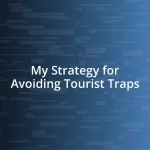Key takeaways:
- Language barriers can be challenging but learning essential phrases and using translation tools enhances travel experiences and fosters connections with locals.
- Non-verbal communication, cultural awareness, and visual aids are effective strategies for overcoming communication obstacles and creating meaningful interactions.
- Engaging with locals, finding language exchange partners, and utilizing technology can transform travel experiences, making connections that extend beyond language differences.

Understanding language barriers
Language barriers can feel perplexing and overwhelming, especially when you find yourself in a new country. I remember wandering through a bustling market in Marrakech, struggling to communicate my desire for a simple pair of shoes. In that moment, I felt a mix of frustration and vulnerability, questioning how something so basic could become so complicated.
Have you ever tried to convey something important but found your words lost in translation? That sense of isolation can be profound, and even the most routine interactions can turn into epic challenges. For me, this happened when ordering food in a small Italian village, where my attempts at pronunciation met with puzzled expressions and laughter. It was both embarrassing and enlightening, reminding me of the importance of patience in these moments.
Sometimes, I think about how language is not just a means of communication but also a bridge to understanding culture. Every time I’ve explored a new destination, I’ve found that even a simple “hello” or “thank you” in the local tongue can create connections. It makes me wonder—as travelers, shouldn’t we make an effort to embrace those nuances, no matter how daunting they may seem?

Tools for translation assistance
When it comes to breaking down language barriers, I’ve found that technology can be a lifesaver. During a trip to Japan, I realized I couldn’t read many of the signs and menus. Thankfully, translation apps came to my rescue. They not only helped me navigate the streets but also allowed me to engage more meaningfully with locals.
Here are some top tools I’d recommend for translation assistance:
- Google Translate: Offers text, voice, and camera translations, making it versatile for different situations.
- iTranslate: A user-friendly app that supports voice translations and has an offline mode for when Wi-Fi isn’t available.
- Microsoft Translator: Allows for real-time conversation translation, which can be incredibly helpful during discussions.
- SayHi: Great for spoken translations, enabling easy back-and-forth conversations.
Using these tools has empowered me to connect more genuinely with those I meet. Just the other day, I was able to compliment a local artist in his own language, which sparked a delightful conversation and a deeper connection.

Learning essential phrases
Mastering some essential phrases before traveling can significantly enhance your experience. For instance, I remember sitting in my living room before a trip to Mexico, practicing how to say “por favor” (please) and “gracias” (thank you). The smiles from locals when I used those phrases felt incredibly fulfilling—they treated me more like a friend rather than just another tourist. It’s amazing how respectful communication can break down walls and create camaraderie, even when other words may fail me.
I often incorporate language learning into my travel prep. Last summer, while preparing for a trip to France, I focused on phrases like “Où est la gare?” (Where is the train station?) and “L’addition, s’il vous plaît” (The bill, please). The gratitude in the waitstaff’s eyes after I used these phrases made all the efforts worthwhile. It’s fascinating how a little preparation can open doors to deeper interactions.
Learning just a handful of essential phrases can transform your travel experience. However, the key is to practice them often. When I was in Thailand, I made it a point to learn how to say “sawasdee” (hello)—and that small effort always prompted a friendly response. It’s such a simple element, yet it opened the door for conversations that deepened my appreciation for the culture. After all, it’s not just about the words; it’s about the connections they facilitate.
| Phrase | Language |
|---|---|
| Hello | Sawasdee (Thai) |
| Please | Por favor (Spanish) |
| Thank you | Gratzi (Italian) |
| Where is…? | Où est…? (French) |

Tips for non-verbal communication
Non-verbal communication can be a powerful tool when words elude us. I once found myself in a bustling market in Marrakech, overwhelmed by the sights and sounds. Instead of feeling lost, I decided to smile and gesture, pointing to the vibrant spices I wanted to buy. The vendor’s eyes lit up, and with shared laughter, we managed a conversation through gestures. It was a beautiful reminder that a smile can speak volumes when language fails.
When communicating non-verbally, it’s essential to be aware of cultural differences. I remember being in Italy, where I accidentally used an exaggerated hand gesture I thought was friendly. Instead, it was interpreted differently, causing a brief moment of confusion. This experience taught me to observe local customs closely, as small nuances can significantly impact our interactions. How can we expect to connect if we overlook these details? Paying attention to body language, tone, and facial expressions provides context that can bridge communication gaps.
Another effective strategy I discovered is using visual aids. On a trip to South Korea, I carried a small notebook where I drew simple images of what I needed, like food or directions. When I handed it to a passerby, their face transformed into a smile as they realized I was trying to communicate, and they eagerly helped me find my way. This encounter reinforced my belief that creativity in communication not only resolves challenges but also fosters delightful connections. Have you ever used visuals to express yourself? It’s a fun and engaging method that can enhance your travel experiences!

Engaging with local speakers
Engaging with local speakers can really transform your travel experience. I remember visiting a small village in Italy, where speaking the local dialect was more than just communication; it was a cultural exchange. One afternoon, I struck up a conversation with an elderly man in a quaint café. Despite my limited Italian, his enthusiasm and the sparkle in his eyes told me that every effort mattered. There’s something magical about those human connections that go beyond words.
I often find that locals appreciate when I make an effort to speak their language, even if it’s just a few phrases. On a trip to Japan, I met a woman at a noodle shop who was delighted when I muddled through ordering in Japanese. The joy on her face was infectious, and soon we were sharing stories about our cultures through a mix of gestures and broken language. Have you ever felt that exhilarating connection with someone even though you both spoke different languages? It’s those moments that enrich our travels and make us feel at home, no matter where we are.
Another thing I’ve discovered is how powerful asking for help can be. In Greece, when I needed directions to a little beach, I was nervous to approach the locals because of my language limitations. But as soon as I asked a group of young people for assistance, they rushed over, excited to practice their English and share their tips. Their open-heartedness reminded me that curiosity and kindness can break through any barrier. Why not reach out to someone nearby and see where the conversation takes you? You might just create a memorable connection that lasts long after the trip is over.

Finding language exchange partners
One of the most rewarding ways I’ve navigated language barriers is by finding language exchange partners. During my time in Barcelona, I discovered a local language exchange group through social media. At our first meeting, I felt a mix of excitement and nerves, wondering how much Spanish I would actually use. But as we began to chat over tapas, I realized that everyone had come to learn and share, creating a warm atmosphere where mistakes were not just accepted but embraced. Who knew that struggling to find the right words could lead to such genuine connections?
I also turned to apps designed for language learners. Using one like Tandem, I matched with a fantastic partner from Brazil who wanted to practice English. We scheduled weekly video calls, and each session became a blend of language practice and discovery of our cultures. I cherished how our conversations flowed from language drills to sharing our favorite music. It really highlighted how a simple app could open doors to friendships that span the globe. Have you ever thought about how technology can make reaching out so easy?
Additionally, attending local events related to language learning has proven invaluable. I recall stumbling upon a poetry night in a Swiss café, where participants could read their pieces in their native languages. Taking the plunge and sharing one of my own poems—albeit in shaky French—felt exhilarating! The audience’s applause and encouragement flooded me with warmth. It was a turning point, showing me that stepping out of my comfort zone could lead to rewarding experiences. What unique methods have you tried to connect with locals? Sometimes, the most unexpected opportunities can lead to the best memories.

Using technology for seamless communication
Using technology for seamless communication can truly transform the way we interact while traveling. I vividly remember my trip to South Korea, where I relied on translation apps to navigate menus and conversations. It was a game-changer! One night, I used an app to ask a local where to find the best street food. The joy of watching their face light up as we exchanged recommendations was priceless. How often can a simple app lead to rich culinary adventures?
One of the most fascinating experiences I’ve had with technology was when I tried a real-time translation device during a bus tour in Prague. I’ll never forget the feeling of ease as I listened to the local guide’s stories in my language. This little gadget allowed me to immerse myself in the culture without worrying about missing out on important details. Have you ever experienced that sense of relief when technology bridges the gap in communication? It’s moments like these that remind me of how innovative tools can enhance our travels.
On another occasion, I discovered virtual reality language immersion programs. I found myself exploring the vibrant streets of Mexico City from the comfort of my home, interacting with characters who spoke only Spanish. This not only honed my conversational skills but also made me feel more prepared for the real-life interactions I would soon have. Isn’t it incredible how technology can prep us for these face-to-face encounters? For me, it amplified my confidence significantly, transforming the typical travel nerves into excitement for engaging with locals.














